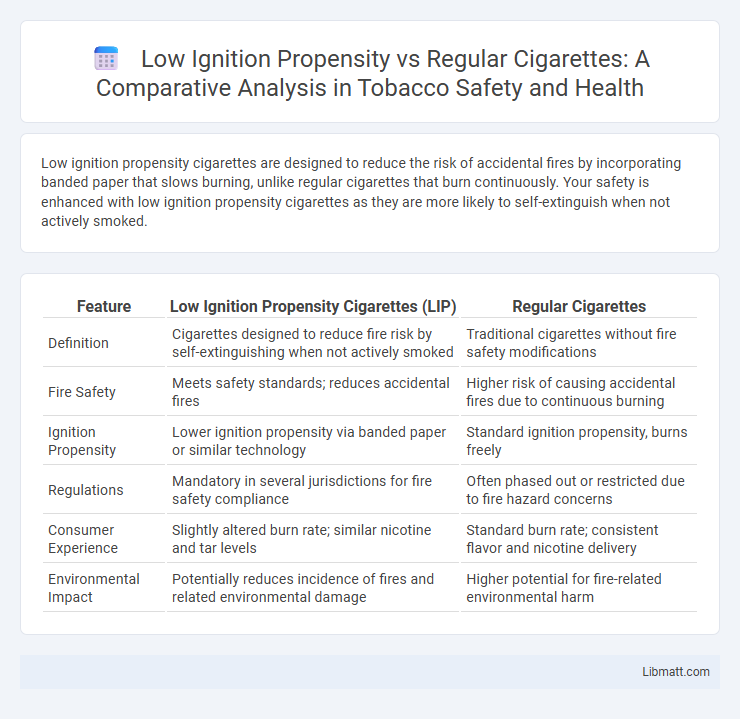Low ignition propensity cigarettes are designed to reduce the risk of accidental fires by incorporating banded paper that slows burning, unlike regular cigarettes that burn continuously. Your safety is enhanced with low ignition propensity cigarettes as they are more likely to self-extinguish when not actively smoked.
Table of Comparison
| Feature | Low Ignition Propensity Cigarettes (LIP) | Regular Cigarettes |
|---|---|---|
| Definition | Cigarettes designed to reduce fire risk by self-extinguishing when not actively smoked | Traditional cigarettes without fire safety modifications |
| Fire Safety | Meets safety standards; reduces accidental fires | Higher risk of causing accidental fires due to continuous burning |
| Ignition Propensity | Lower ignition propensity via banded paper or similar technology | Standard ignition propensity, burns freely |
| Regulations | Mandatory in several jurisdictions for fire safety compliance | Often phased out or restricted due to fire hazard concerns |
| Consumer Experience | Slightly altered burn rate; similar nicotine and tar levels | Standard burn rate; consistent flavor and nicotine delivery |
| Environmental Impact | Potentially reduces incidence of fires and related environmental damage | Higher potential for fire-related environmental harm |
Introduction to Low Ignition Propensity (LIP) Cigarettes
Low Ignition Propensity (LIP) cigarettes are designed with reduced flammability to decrease the risk of accidental fires caused by unattended burning cigarettes. These cigarettes incorporate specially treated paper and strategic banding to slow the burn rate, ensuring the cigarette self-extinguishes if left unattended. Compared to regular cigarettes, LIP cigarettes maintain similar smoking experience while significantly enhancing fire safety and compliance with fire prevention regulations.
What Are Regular Cigarettes?
Regular cigarettes are tobacco products designed for conventional smoking, composed of shredded tobacco wrapped in paper without specialized features to reduce fire risk. They typically lack low ignition propensity technology, causing them to burn continuously when lit, increasing the chance of accidental fires. These cigarettes deliver nicotine and tar through combustion, contributing to health risks associated with smoking.
Key Differences Between LIP and Regular Cigarettes
Low ignition propensity (LIP) cigarettes are designed with reduced ignition risk to help prevent accidental fires by using special paper that self-extinguishes when not actively puffed. Regular cigarettes lack these safety features, often burning continuously and increasing fire hazards. Your choice of LIP cigarettes can significantly enhance fire safety without compromising smoking experience.
How LIP Cigarettes Reduce Fire Risks
Low ignition propensity (LIP) cigarettes are designed with special paper that slows the burning rate, significantly reducing the likelihood of accidental fires. Unlike regular cigarettes, LIP cigarettes self-extinguish when not actively puffed, limiting the chances of ignition from unattended smoldering. Your safety improves with LIP cigarettes as they meet fire safety standards aimed at minimizing fire hazards related to smoking.
Regulatory Requirements for LIP Cigarettes
Low ignition propensity (LIP) cigarettes are designed to meet stringent regulatory requirements aimed at reducing fire risks by controlling burn rates and self-extinguishing properties. Regulations typically mandate that LIP cigarettes pass standardized testing protocols, such as ASTM E2187, to ensure they extinguish promptly when not actively smoked, significantly lowering accidental fires. You must verify compliance with national and regional standards, like those enforced by the U.S. CPSC or Canadian Fire Safe Cigarette regulations, to align your product with legal safety criteria.
Manufacturing Process: LIP vs Regular Cigarettes
Low Ignition Propensity (LIP) cigarettes are manufactured with specially designed paper that includes reduced-burn bands, slowing the burning rate to decrease the risk of accidental fires. The manufacturing process for LIP cigarettes requires precise application of these burn-control materials, differing significantly from regular cigarettes, which use standard paper without fire-retardant additives. Your choice of LIP cigarettes supports enhanced safety standards, as the production incorporates advanced technology to minimize ignition hazards without compromising the smoking experience.
Health Implications: LIP Compared to Regular Cigarettes
Low ignition propensity (LIP) cigarettes reduce the risk of accidental fires by limiting how easily they ignite flammable materials, which significantly decreases fire-related injuries and fatalities compared to regular cigarettes. While both LIP and regular cigarettes expose users to harmful chemicals like tar, nicotine, and carbon monoxide, LIP cigarettes do not demonstrate a reduction in health hazards such as lung cancer, cardiovascular disease, or respiratory issues. Your choice of LIP cigarettes primarily enhances safety by preventing ignition-related accidents rather than improving direct health outcomes linked to smoking.
Consumer Reception and Market Trends
Low ignition propensity cigarettes, designed to reduce fire risks, have seen mixed consumer reception due to perceived changes in taste and burn quality compared to regular cigarettes. Market trends indicate a gradual increase in demand driven by stricter fire safety regulations and growing public awareness about fire hazards linked to smoking. Your choice between these options may reflect a balance between safety concerns and smoking experience preferences.
Safety and Effectiveness of LIP Cigarettes
Low ignition propensity (LIP) cigarettes are designed with reduced ignition potential by incorporating materials like porous paper or thicker wrappers, significantly lowering the risk of accidental fires compared to regular cigarettes. Studies show that LIP cigarettes can self-extinguish when not actively smoked, enhancing fire safety without compromising nicotine delivery or user satisfaction. Your choice of LIP cigarettes contributes to greater fire prevention while maintaining the smoking experience similar to regular cigarettes.
Future of Cigarette Safety Technologies
Low ignition propensity (LIP) cigarettes are engineered to reduce fire risks by slowing or stopping the burn when not actively smoked, contrasting with regular cigarettes that pose higher fire hazards. Innovations in cigarette safety technologies are advancing with smart materials and sensors to further minimize ignition potential and enhance user safety. Your safety could significantly improve as future designs integrate these cutting-edge features to prevent accidental fires caused by cigarette use.
Low ignition propensity vs Regular cigarette Infographic

 libmatt.com
libmatt.com